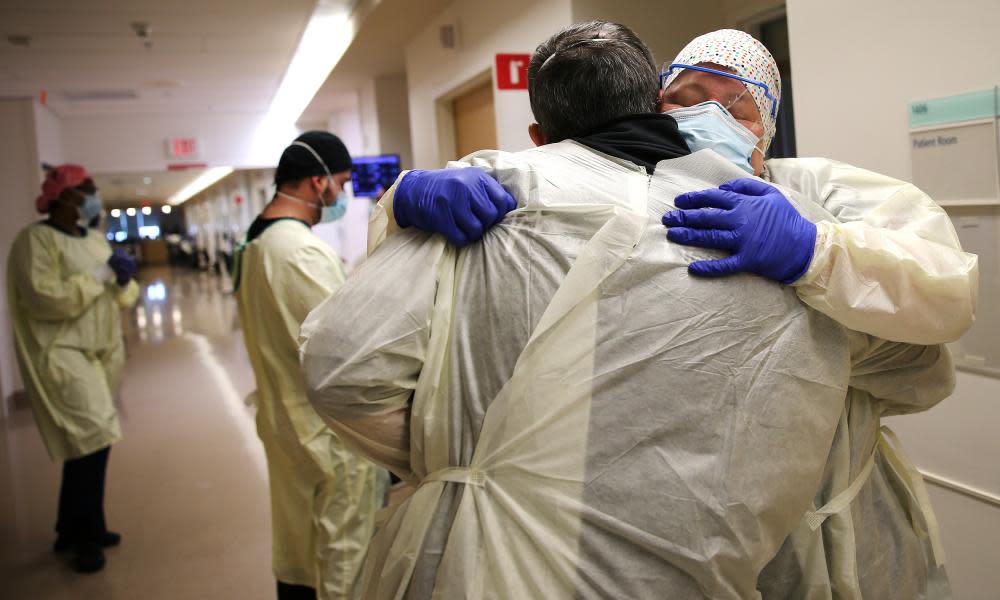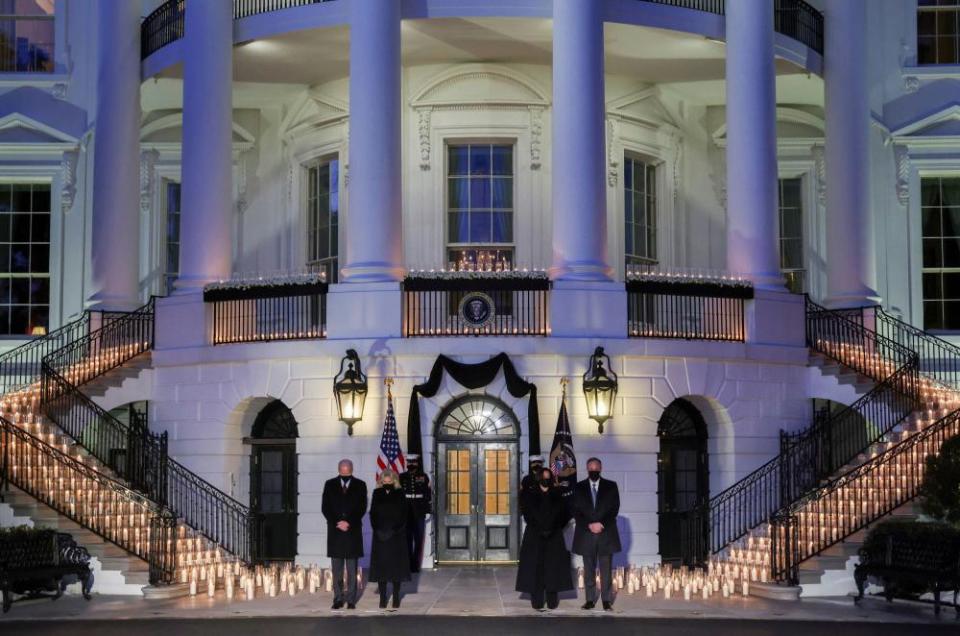US coronavirus death toll passes 500,000 after devastating winter surge

More than 500,000 people have now died from Covid-19 in the US, just over a year after the country detected its first cases of a virus that has wrought almost unprecedented loss.
Deaths breached half a million on Monday, according to data from Johns Hopkins University, bringing the total to 500,071 . More than 28 million people have also tested positive for coronavirus in the US.
Both numbers are the worst in the world and the pandemic has thrown a harsh spotlight on the country’s ability to cope with such a disaster, especially during the tumultuous tenure of Donald Trump, whose administration botched the government response.
In a primetime address on Monday night, Joe Biden spoke to the gravity of the milestone.
“As a nation, we can’t accept such a cruel fate,” the president said in a speech, which was followed by a moment of silence and candle lighting ceremony at the White House. “While we’ve been fighting this pandemic for so long, we have to resist becoming numb to the sorrow. We have to resist viewing each life as a statistic.”
After a devastating winter surge in cases, for the first time in months, the average number of daily new coronavirus cases in the US fell below 100,000 on 12 February. Even with the decrease in cases, the US is still experiencing 1,500 to 3,500 deaths a day and public health officials have warned recent progress could easily reverse.
Perhaps the biggest threat is the new variants of the virus, which appear to spread more quickly and easily. Scientists are working to understand how these variants could change the effectiveness of vaccines as the US attempts to ramp up the scale of its inoculation distribution.
About 13% of the US population, or 43 million people, have received their first dose of the vaccine, according to the Washington Post. Biden pledged this month to make 600m doses of the vaccine available by the end of July.
To avoid another spike in cases, the director of the Centers for Disease Control and Prevention (CDC), Rochelle Walensky, said mask-wearing guidelines must remain in place and people must continue to use physical distancing to stop the virus’s spread.
A year on from the first known Covid infections in the US, Joe Biden’s administration has made the health and economic response to the pandemic a White House priority, after Donald Trump spent most of 2020 minimizing and dismissing its grim toll.
In the first year of the pandemic, more people died from Covid-19 than those who die from respiratory diseases, guns and car crashes in the US in an average year.

Earlier this month, a Lancet commission said the US could have averted 40% of the deaths from Covid-19, had the country’s death rates corresponded with the rates in other high-income G7 countries.
Trump’s administration reacted slowly at the start of the pandemic and then frequently sought to undermine the science around the virus, including spreading unfounded conspiracy theories and unverified treatments. Trump, who was eventually infected himself, especially inflamed racial tensions by blaming China and also flouting widely accepted practices, such as mask-wearing.
Dr Anthony Fauci, the nation’s top infectious disease expert, said political divisiveness – which helped transform mask wearing from a public health measure to a political statement – has contributed significantly to the “stunning” Covid death toll.
Meanwhile the emergence of more contagious variants of the coronavirus – especially those from South Africa and Brazil, which have been shown to reduce the immunity from natural infections and vaccines – have made it challenging to predict when the US will be able to put the pandemic behind it, Fauci told Reuters in an interview Monday.
Fauci and Biden have said the United States should return to something approaching pre-pandemic normal life around Christmas. But that could change, Fauci cautioned.
Covid-19 deaths, hospitalizations and cases have disproportionately affected Black, Latino and Indigenous people. American Indian or Alaska Native people have died at 2.4 times the rate of white people, Black people at 1.9 times the rate and Latino people at 2.3 times the rate, according to the CDC.
It’s been just over a year since the first known US death from Covid-19 on 6 February 2020, though the death wasn’t reported until April of that year. In early February 2020, the country’s first confirmed cases were detected in people returning from abroad, though it is now believed the virus had been spreading in the country for months before.
It was in Seattle in late February 2020 that the quick spread of the illness became evident to the US, as the virus swept through a long-term care facility, leading to the deaths of at least 46 people.
Local lockdowns were soon implemented in many parts of the country, and by early April, New York City had become the center of the global outbreak.
In October, scientists at the University of Washington warned the US death toll could reach half a million people by the end of February. The University’s Institute for Health Metrics and Evaluation now projects the death toll will be 616,000 by 1 June.
The scientists said the trajectory of the next four months will be determined by vaccine distribution, declining virus transmission in warmer months, new variants and individual adherence to mask-wearing and other public health guidelines.
Lois Beckett and agencies contributed reporting

